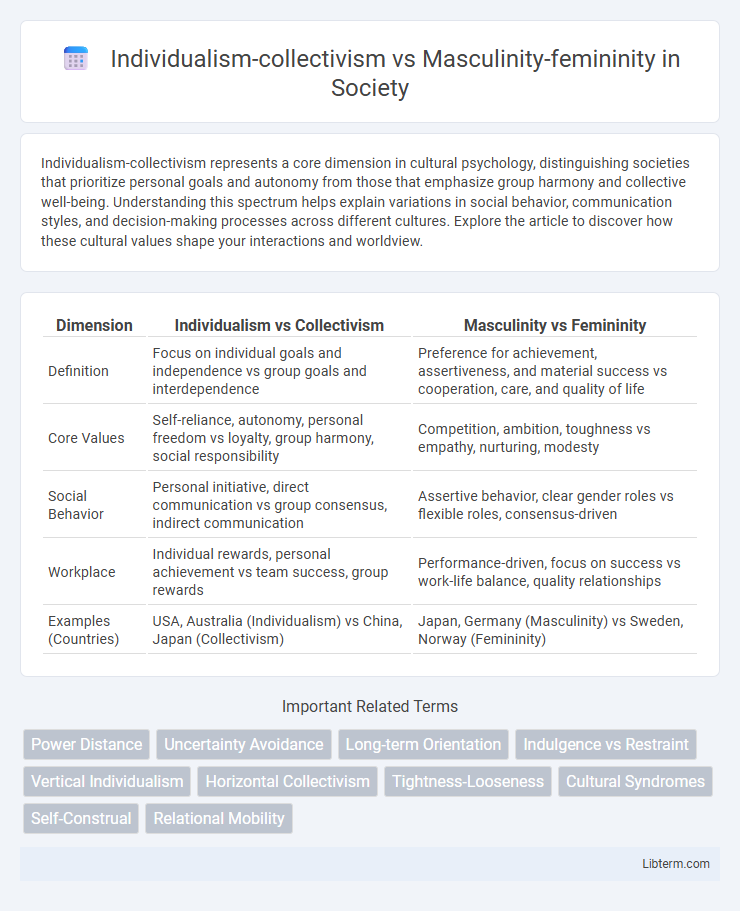Individualism-collectivism represents a core dimension in cultural psychology, distinguishing societies that prioritize personal goals and autonomy from those that emphasize group harmony and collective well-being. Understanding this spectrum helps explain variations in social behavior, communication styles, and decision-making processes across different cultures. Explore the article to discover how these cultural values shape your interactions and worldview.
Table of Comparison
| Dimension | Individualism vs Collectivism | Masculinity vs Femininity |
|---|---|---|
| Definition | Focus on individual goals and independence vs group goals and interdependence | Preference for achievement, assertiveness, and material success vs cooperation, care, and quality of life |
| Core Values | Self-reliance, autonomy, personal freedom vs loyalty, group harmony, social responsibility | Competition, ambition, toughness vs empathy, nurturing, modesty |
| Social Behavior | Personal initiative, direct communication vs group consensus, indirect communication | Assertive behavior, clear gender roles vs flexible roles, consensus-driven |
| Workplace | Individual rewards, personal achievement vs team success, group rewards | Performance-driven, focus on success vs work-life balance, quality relationships |
| Examples (Countries) | USA, Australia (Individualism) vs China, Japan (Collectivism) | Japan, Germany (Masculinity) vs Sweden, Norway (Femininity) |
Defining Individualism-Collectivism and Masculinity-Femininity
Individualism-collectivism defines the extent to which individuals prioritize personal goals over group goals, with individualistic cultures emphasizing autonomy and collectivist cultures valuing group harmony. Masculinity-femininity contrasts societies that prioritize achievement, assertiveness, and material success (masculine) against those that emphasize care, cooperation, and quality of life (feminine). These cultural dimensions shape social behaviors, communication styles, and organizational practices across different societies.
Historical Origins of the Cultural Dimensions
Individualism-collectivism and masculinity-femininity are cultural dimensions identified by Geert Hofstede through extensive research in the 1970s, rooted in contrasting societal values shaped by historical, economic, and environmental factors. Individualism-collectivism reflects the degree to which societies prioritize personal autonomy versus group cohesion, influenced by agrarian or industrial histories that emphasize independent work or communal labor. Masculinity-femininity captures the value placed on competitiveness and achievement versus care and cooperation, emerging from socio-economic conditions in which resource scarcity or abundance shaped gender roles and social expectations.
Core Values of Individualistic vs Collectivist Societies
Individualistic societies prioritize personal autonomy, self-expression, and individual achievement, emphasizing independence and personal rights as core values. Collectivist cultures value group harmony, social cohesion, and collective well-being, prioritizing interdependence, loyalty, and shared responsibilities. The contrast between these core values shapes social behaviors, decision-making processes, and conflict resolution strategies within each society.
Traits of Masculine and Feminine Cultures
Masculine cultures prioritize competitiveness, assertiveness, and material success, emphasizing achievement and ambition as key societal values. Feminine cultures value cooperation, care for the weak, and quality of life, fostering nurturing relationships and a balance between work and personal life. These traits influence workplace dynamics, communication styles, and social roles within different societies.
Intersections: How Individualism-Collectivism Relates to Masculinity-Femininity
Individualism-collectivism and masculinity-femininity intersect by influencing societal values on personal achievement versus group harmony, where individualistic cultures often emphasize masculine traits like competitiveness and assertiveness. In contrast, collectivist cultures tend to align more with feminine traits such as cooperation and caring for others, promoting social cohesion. This intersection shapes communication styles, conflict resolution, and organizational behavior across cultures.
Communication Styles Across the Dimensions
Individualism-collectivism influences communication styles by promoting direct, explicit exchanges in individualistic cultures where personal expression is valued, whereas collectivist cultures emphasize indirect, context-sensitive communication to maintain group harmony. Masculinity-femininity affects communication through task-oriented, assertive dialogue in masculine societies, contrasting with collaborative, empathetic, and relationship-focused interactions typical of feminine cultures. Understanding these cultural dimensions enhances cross-cultural communication effectiveness by aligning language use with underlying societal values and expectations.
Workplace Dynamics and Leadership Influences
Individualism-collectivism shapes workplace dynamics by influencing communication styles, decision-making processes, and team collaboration, with individualistic cultures emphasizing autonomy and personal achievement while collectivist cultures prioritize group harmony and consensus. Masculinity-femininity affects leadership influences by defining valued traits, where masculine cultures favor competitiveness, assertiveness, and goal orientation, and feminine cultures highlight empathy, cooperation, and work-life balance. Understanding these cultural dimensions enables global organizations to tailor leadership approaches and enhance team performance across diverse cultural settings.
Effects on Conflict Resolution and Decision-Making
Individualism-collectivism influences conflict resolution by prioritizing either personal goals or group harmony, with individualistic cultures favoring direct confrontation and collectivist cultures opting for consensus-building to preserve relationships. Masculinity-femininity affects decision-making styles where masculine cultures emphasize competitiveness and assertiveness, leading to more combative conflict approaches, while feminine cultures value cooperation and empathy, promoting collaborative solutions. Together, these cultural dimensions shape how organizations and teams navigate disagreements and reach decisions, balancing assertiveness with relational sensitivity.
Implications for Cross-Cultural Relationships
Individualism-collectivism emphasizes the degree to which people prioritize personal goals versus group harmony, influencing communication styles and conflict resolution in cross-cultural relationships. Masculinity-femininity reflects societies' values on competitiveness versus cooperation, affecting expectations around roles, assertiveness, and emotional expression between partners. Understanding these cultural dimensions helps navigate differences in decision-making, emotional needs, and social obligations, fostering mutual respect and effective collaboration in diverse relationships.
Globalization and Shifting Cultural Paradigms
Globalization accelerates the blending of individualism-collectivism and masculinity-femininity cultural dimensions, reshaping societal values and workplace behaviors worldwide. Collectivist societies increasingly adopt individualistic traits, while traditionally masculine cultures integrate more feminine attributes such as cooperation and empathy to thrive in diverse, global markets. This cultural convergence influences multinational strategies, leadership styles, and cross-cultural communication, framing a dynamic landscape of evolving social norms.
Individualism-collectivism Infographic

 libterm.com
libterm.com